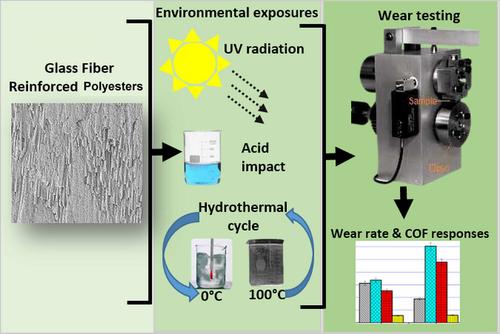当前位置:
X-MOL 学术
›
Polym. Compos.
›
论文详情
Our official English website, www.x-mol.net, welcomes your feedback! (Note: you will need to create a separate account there.)
Investigation of effects of environmental conditions on wear behaviors of glass fiber reinforced polyester composite materials
Polymer Composites ( IF 4.8 ) Pub Date : 2024-09-03 , DOI: 10.1002/pc.28992 Mihriban Korku 1 , Recep İlhan 2, 3 , Erol Feyzullahoğlu 4
−14 m3 /Nm in non‐treated sample, 6.05 × 10−14 m3 /Nm in acid environment, 4.79 × 10−14 m3 /Nm in hydrothermal cycle and 0.59 × 10−14 m3 /Nm in UV radiation.Highlights Friction coefficient of glass fiber reinforced polyester (GFRP) is higher under aged condition compared to non‐treated. Glass fibers used in correct proportions can reduce friction coefficient in GFRP. GFRP exposed to environmental conditions has an important effect on wear. Acid environment and hydrothermal cycle has reduced wear resistance of GFRP. UV radiation improved wear resistance of GFRP composite.
中文翻译:

环境条件对玻璃纤维增强聚酯复合材料磨损行为影响的研究
玻璃纤维增强聚合物(GFRP)复合材料在其使用环境中可以承受不同的环境条件,例如温度、湿度、紫外线辐射、水热循环、酸性和碱性溶液。这些环境条件会导致复合材料产生不同的损伤机制,例如孔隙形成、微裂纹、分层、纤维断裂、纤维/基体界面分离、塑化、膨胀和表面颜色变化。在这项研究中,根据材料含量和环境条件,全面检查了混合玻璃纤维增强聚合物复合材料在恒定载荷(60 N)、速度(500 rpm)和2小时的各种环境条件下的磨损性能。在这项实验研究中,使用酸性环境、水热循环和紫外线辐射等不同的人工老化环境来模拟玻璃纤维增强复合材料的使用条件。除了材料含量之外,复合材料所处的环境条件似乎对摩擦系数也有显着影响。考虑到环境条件,酸性环境和水热循环降低了GFRP复合材料的耐磨性,而紫外线辐射则提高了复合材料的耐磨性。在C2样品中,不同条件下的磨损率分别为:未处理样品为1.87×10−14 m3/Nm,酸性环境为6.05×10−14 m3/Nm,水热循环为4.79×10−14 m3/Nm,水热循环为0.59 × 10−14 m3/Nm(紫外线辐射)。亮点 与未经处理的相比,玻璃纤维增强聚酯 (GFRP) 在老化条件下的摩擦系数更高。按正确比例使用玻璃纤维可以降低 GFRP 的摩擦系数。 暴露于环境条件下的 GFRP 对磨损有重要影响。酸性环境和水热循环降低了GFRP的耐磨性。紫外线辐射提高了 GFRP 复合材料的耐磨性。
Polymer Composites ( IF 4.8 ) Pub Date : 2024-09-03 , DOI: 10.1002/pc.28992 Mihriban Korku 1 , Recep İlhan 2, 3 , Erol Feyzullahoğlu 4
Affiliation

|
中文翻译:

环境条件对玻璃纤维增强聚酯复合材料磨损行为影响的研究
玻璃纤维增强聚合物(GFRP)复合材料在其使用环境中可以承受不同的环境条件,例如温度、湿度、紫外线辐射、水热循环、酸性和碱性溶液。这些环境条件会导致复合材料产生不同的损伤机制,例如孔隙形成、微裂纹、分层、纤维断裂、纤维/基体界面分离、塑化、膨胀和表面颜色变化。在这项研究中,根据材料含量和环境条件,全面检查了混合玻璃纤维增强聚合物复合材料在恒定载荷(60 N)、速度(500 rpm)和2小时的各种环境条件下的磨损性能。在这项实验研究中,使用酸性环境、水热循环和紫外线辐射等不同的人工老化环境来模拟玻璃纤维增强复合材料的使用条件。除了材料含量之外,复合材料所处的环境条件似乎对摩擦系数也有显着影响。考虑到环境条件,酸性环境和水热循环降低了GFRP复合材料的耐磨性,而紫外线辐射则提高了复合材料的耐磨性。在C2样品中,不同条件下的磨损率分别为:未处理样品为1.87×10−14 m3/Nm,酸性环境为6.05×10−14 m3/Nm,水热循环为4.79×10−14 m3/Nm,水热循环为0.59 × 10−14 m3/Nm(紫外线辐射)。亮点 与未经处理的相比,玻璃纤维增强聚酯 (GFRP) 在老化条件下的摩擦系数更高。按正确比例使用玻璃纤维可以降低 GFRP 的摩擦系数。 暴露于环境条件下的 GFRP 对磨损有重要影响。酸性环境和水热循环降低了GFRP的耐磨性。紫外线辐射提高了 GFRP 复合材料的耐磨性。







































 京公网安备 11010802027423号
京公网安备 11010802027423号